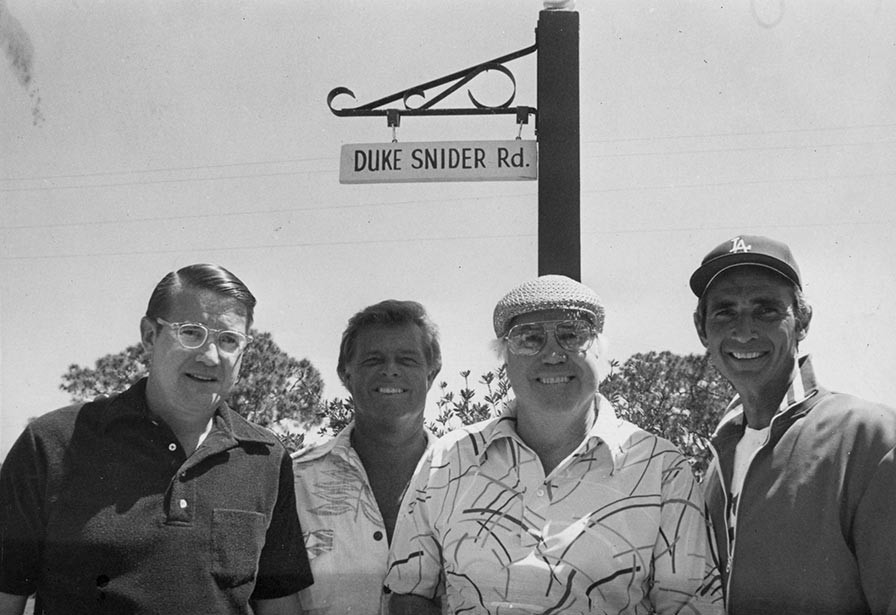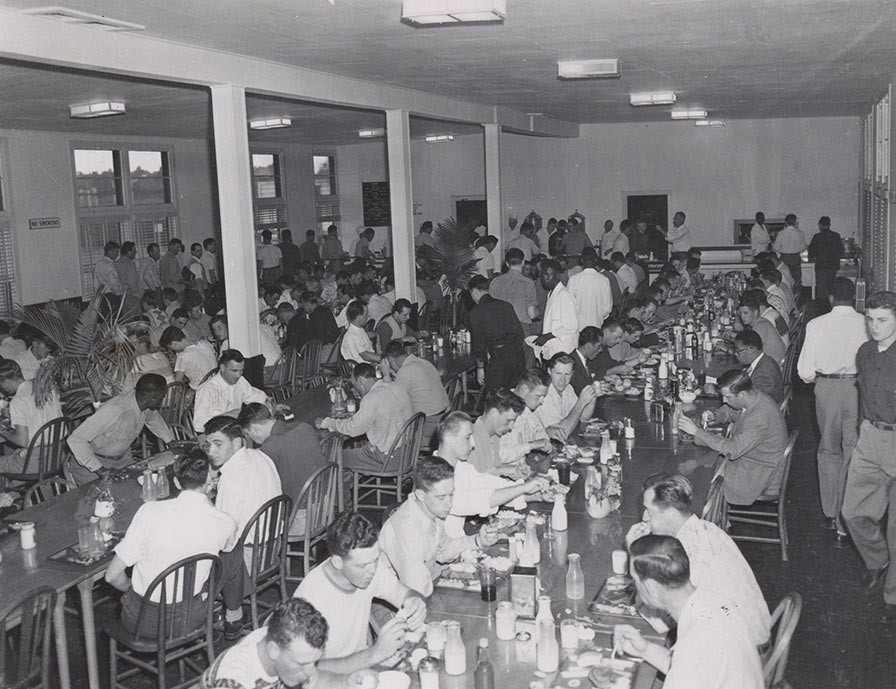Dodgertown Memories
Duke Snider
- Center fielder
- 1947–62

Legendary Duke Snider stands at his street sign on the day of its dedication in 1980. “Duke Snider Road” was named in his honor at Dodgertown, as fellow teammates (l-r) Sandy Koufax and Don Drysdale, along with Dodger President Peter O’Malley, join the celebration.
Recognized as one of baseball’s all-time premier players, Edwin “Duke” Snider’s outstanding career for the Dodgers earned him an induction into the Baseball Hall of Fame in 1980. Originally from Compton, California, the left-handed hitting Snider first joined the Dodgers in 1947. Snider’s popularity with the fans and his impact on the talented Dodger lineup of the 1950s gave him the title of the “Duke of Flatbush.” He played in six World Series for the Dodgers for a total of 36 W.S. games. When the Dodgers won their first and only World Series Championship in Brooklyn in 1955, Snider was a major Series contributor, batting .320 with four home runs and seven RBI. He became the first player to hit four homers in two different World Series (also in 1952). The eight-time National League All-Star (including with the Mets) is the Dodgers’ all-time leader in home runs with 389, RBI with 1,271 and extra-base hits with 814. Snider belted 40 home runs or more in five consecutive seasons. He holds the all-time single-season home run record in Brooklyn with 43. New Yorkers could boast about three of the game’s greatest center fielders in the same era – Willie Mays, Mickey Mantle and Duke, all Hall of Famers.

The Dodgertown dining room with a buffet line for breakfast, lunch, and dinner. Dodgertown was notable for being the only integrated Spring Training quarters in the South when it first opened in 1948, meaning all players, regardless of color of skin or national origin, would eat together.
It was a Navy Air Base housing facility at that particular time. It wasn’t too pleasant. You had to walk through these vacant lots and there were paths, but there would be snakes. You’d always take a bat with you just in case you needed it. I went after a ball when the main ballpark was over by the airport and there was sort of a ditch in left and right field and it had all grass, big bladed grass, and a ball got in between the left fielder and myself and we went over for it. I started down the ditch to get the ball, because it was in play, and there was a snake down there right by the ball. The guy got an inside-the-park home run! I wasn’t going to go down and get that ball. They had bleachers stacked on both sides, first base, third base and behind home plate. It wasn’t much of a ballpark, but it was better than nothing, I guess. We played a couple of games in Vero, not very many, until Holman Stadium was built (in 1953) and then we played games at Holman Stadium. Your food was military style; you had a metal tray that you took around and they put a little bit of this and a little bit of that on it and you’d go sit down and eat. The food wasn’t all that great at that particular time, but it was better than nothing. As hard as you worked down there, you were pretty hungry when you went in there to eat. I was only in the barracks. Of course, I got into the other units (the villas) later on. The walls were paper thin; there were just bunks for beds. There were quite a few insects, spiders and mosquitoes that you had to cope with. It wasn’t all that pleasant, but it kept you out of the rain and the cold or warm weather, whatever.
“We were all down there for the same purpose: to improve ourselves to get to the big leagues and to become a major league ballplayer. We had close to seven hundred players at one time, I guess. Some of the teams – I wasn’t involved with this – but instead of names on the front, the numbers on their backs were different colors. It would be the yellow team, the blue team, the green team, the purple team or whatever. That’s what team you would be known as when you played your games, because there were so many players. In the mornings you went through special drills and then you played your games in the afternoon. It was a pretty full day. There was a lecture. (Dodger President Branch) Rickey always had a lecture every morning, it was where they had movies, there was an auditorium that was down the road just a little bit from the barracks toward the airport and they’d show movies at night in there in fold-up chairs. You would sit in there to watch the movies and for Rickey’s lectures you’d sit in those (same) chairs. He’d school you pretty good on the fundamentals of the game. I went to quite a few of those and learned an awful lot. He’d pick out a certain guy and ask him a question or something and put him on the spot every once in a while, but he was a great teacher and had the foresight to know just what each player needed and what he had to work on and how it could be corrected or improved on. It was quite an interesting time with him down there. Baseball was the main topic (of conversation). I don’t know if you would classify it as fun or not, it was interesting. We were all down there for the same purpose: to improve ourselves to get to the big leagues and to become a major league ballplayer. There was a lot of competition.
“I knew I wasn’t ready yet. I was still very young and inexperienced. I had a lot to work on which Rickey, in turn, took me over there (to Dodgertown) from the Dominican Republic (in 1948) and worked on me as far as hitting the off-speed pitch, the breaking ball and learning my own strike zone and things like that. I had special instruction every morning and played in a game every afternoon. That’s where I learned how to improve myself. I never felt I had arrived until I finally got into the big leagues and had a decent year and then I felt like I somewhat belonged because I held my own as far as batting average and fielding and everything else was concerned.
“I know all the managers of these minor league teams would have the midnight duty to catch guys who came in late – midnight was the curfew. And these two guys were climbing into this room and (Managers) Rube Walker and Roy Hartsfield were out having the duty that night and hollered at them and the two guys ran away. The one guy ran pretty fast and Hartsfield says, ‘C’mon Rube, we’ve got to catch these guys and turn them in.’ And Rube says, ‘I ain’t going to turn them in, but I want to catch that first guy that ran, because he can run pretty good and I want him on my team!’
“Nobody had a car, nobody could afford one. They eventually allotted money for us to live off the base and would give us meal money and what have you. Most of the time, we would go down to Barrett’s Steak House in Vero Beach and have dinner. This was a quality steak house. The Ocean Grill was there. That was about the only big restaurant in town at that particular time. Carl Erskine and I rented a house, we shared it from a family in town. Several families would rent their places out and we would go down to the beach and get a place for the short time that we were there. Players now stay in shape year round. Most of us would gain four or five pounds during the winter and then go down and play ourselves into shape in Spring Training and lose those four or five pounds that we had gained. Nowadays, I think they keep themselves in shape a little bit too much and that’s the reason for all of the injuries. Your body, not only your muscles, but your mental condition needs a little vacation from the game of baseball. We used to do that. I played a little bit on Sunday in semi-pro ball during the winter in Southern California, but not every Sunday and sometimes I’d play doubleheaders on Sunday. You had to get away from it and give your mind a rest and your body somewhat of a rest from the everyday eight-month grind that you have. I delivered mail for the Compton Post Office during Christmas (in the 1950s). I didn’t need to work, but it was a piece of change and gave me something to do. I worked in construction with my father-in-law one winter just after Bev and I got married. I went to Spring Training and weighed less than when the season ended I worked so hard. That’s the only time I did that, because I finally realized that my body needed somewhat of a rest during the off-season.
“We have made a lot of good friends through the (Dodgertown) Fantasy Camps. I have enjoyed them. I went to quite a few of them. I got to see a lot of former teammates. A lot of the campers are repeats. They are about to end now, with the last one in February. They are going to have two in February. We are going to the second one, so we want to go to the last one. It’s going to seem strange. Just the way it was laid out I will miss. Once I went to a Fantasy Camp for a week, of either six or seven days, I would not leave Dodgertown for any reason, the whole time I was there. Bev would go to the mall and they would have things for the wives to do, but I would not leave Dodgertown because everything was there. I didn’t need to go anywhere else. It was so well put together and so well thought out; it was all there for you. Once you got there, it was a very comfortable place to be. We’ve enjoyed it start to finish. We enjoyed it more when it became more like a country club. But, basically they put it together very well and they should be very proud of what was done.”
Duke Snider

